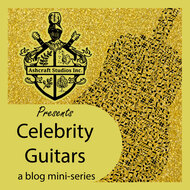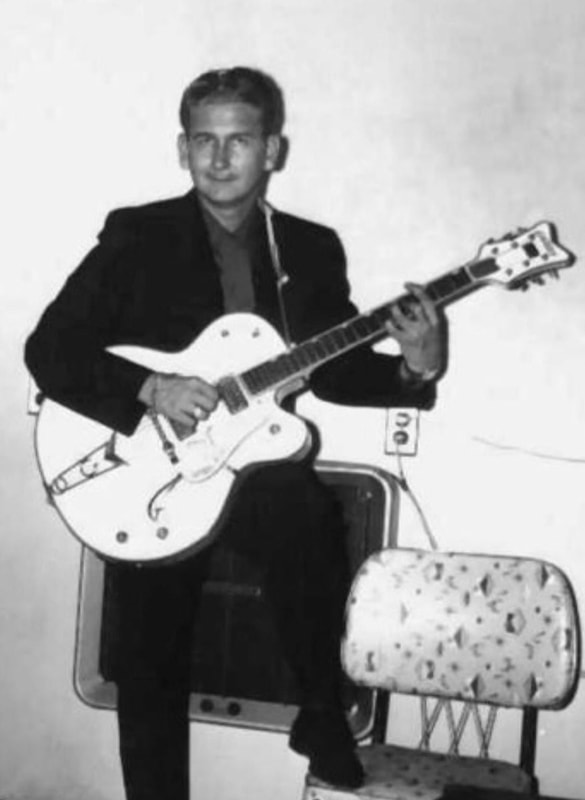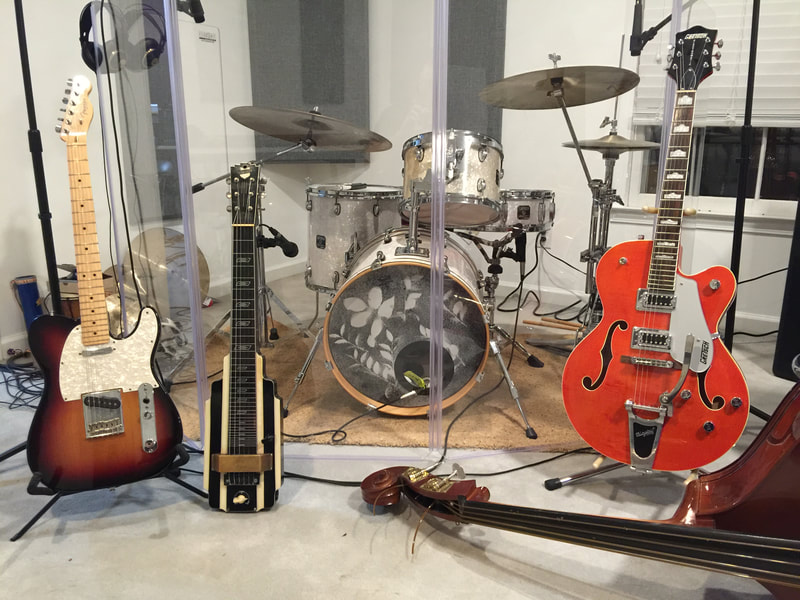 Rockabilly legend Roy Orbison wasn’t your regular rock and roll artist. Challenging the aggressive masculine ideals in the rock and roll world, Orbison was something different. Where other musicians gained notoriety with a bold stage presence and excessive sex appeal, Orbison achieved success through the timid vulnerability his music emoted. As unique as Orbison was to the music world, so was his guitar. The beautiful Gretsch White Falcon he used was revamped and custom fitted to Orbison’s preferences and personality creating an iconic image fans would never forget. The White Falcon first debuted at the NAMM (National Association of Music Merchants) Show in Chicago in 1954. Presented by Jimmie Webster who was inspired by auto shows and Detroit auto makers, the guitar was only meant to be a prototype to boost interest in the company’s product line. With a white body and 24 karat gold appointments, the instrument was a piece of luxury and an instant hit. Spectators at the show fawned over the feather-engraved inlays and the tailpiece that looked something like a Cadillac hood ornament. To Webster’s surprise orders for the new guitar began to flood in. Gretsch taking note decided to leave the prototype status behind and in 1955 the official White Falcon line was born. Pricing started at $600, which by today’s standards would be about $5,500. Considering that the average household income at the time was $5,000, the “Cadillac of Guitars” became more like the “Rolls Royce of Guitars.” The Falcon line continued to sell, seeing some changes here and there. The bulk of the changes occurred during the seventeen-year period in which Baldwin controlled Gretsch guitars. In the 1970s Baldwin began to change the guitars by featuring smaller F-holes, a squared-off pick guard, and square pearl block neck inlays. But the piano manufacturer’s strengths were not in guitars, so in 1984 the company released Gretsch control back to the family in the hands of Fred W. Gretsch, great grandson of founder Friedrich Gretsch. By 1990 Gretsch guitars began to look more like it’s original 1950’s to 1960’s self again. Today the line of guitars includes a bass, jumbo and parlor acoustic guitars, center block and junior sized models, as well as two artist signature models, Stephen Stills and Billy Duffy. Other celebrity users of the guitar include Mary Osborne, Neil Young, Malcolm Young, Brian Setzer, and John Frusciante. Roy Orbison was born on April 23, 1936 in Vernon, Texas. Although he asked for a harmonica for his sixth birthday, his father bought him his first guitar instead. Teaching Orbison how to play the guitar soon became a family affair as both his father, Orbie Lee, and Uncle, Charlie Orbison, both taught the budding musician how to play. Orbison quickly learned how play the guitar so he could stay up late with the adults playing music. The first song he learned was “You Are My Sunshine.” He wrote his first song, “A Vow of Love” at the age of 8. In 1949 at the age of 13 Orbison started his first band, The Wink Westerners, but he didn’t get his big break until he released “Only the Lonely” in 1961. After Elvis Presley and The Everly Brothers declined to use the song, Orbison decided to recorded it himself. The song soon reached the no. 2 spot on the Billboard singles chart triggering his career as a famous musician. While Orbison enjoyed his fame during the early sixties, a rash of bad luck struck later in the decade leading the musician out of the spotlight. Following the tragedies of losing his wife in a motorcycle accident in 1966 and then the death of two of his sons in a house fire in 1968, Orbison wasn’t able to create any hits and eventually faded away. But when Orbison joined The Eagles on their “Hotel California” tour, and when his duet with Emmylou Harris, “That Lovin’ You Feeling Again” won a Grammy Award, he suddenly found himself in the spotlight once again. He later went on to join The Traveling Wilburys, with musical greats, Tom Petty, Bob Dylan, George Harrison, and Jeff Lynn. Orbison was inducted into the Rock and Roll Hall of Fame in 1987 by Bruce Springsteen who said, “In 1975, when I went into the studio to make Born to Run, I wanted to make a record with words like Bob Dylan that sounded like Phil Spector. But most of all, I wanted to sing like Roy Orbison.” Although some pictures and video can be found of Roy Orbison strumming the classic 1959 White Falcon, a simple Google search will reveal a confusing return of Orbison and a black guitar with the same body but a notably different head. What happened? According to royorbisonjr.com, Roy knocked the headstock off with a rubber mallet and had a Gibson headstock reattached. The guitar was then painted black covering the Gibson logo on the headstock. Roy Orbison never fit the bill for a rock and roll artist. He was a musician that did well in the rockabilly community but made a big comeback when rockabilly was gone. He had an odd sense of fashion, think insurance salesman, and he was known for his almost lifeless stage presence. George Harrison once commented, “He was like marble” in regards to watching Orbison perform. His iconic dark sunglasses were a mistake as he wore them during a performance with the Beatles in 1963. He wore them, not to be cool but out of necessity since his regular glasses were left on a plane the night before. Roy Orbison’s image was never really supposed to be cool or sexy. Like his attire, his music showed vulnerability. The lyrics to his songs express insecurity, fear, and heartache. In an industry that sought success through confidence, Orbison gained favor by exposing the truth of our emotions. So it comes as no surprise that the guitar he would choose to play along his journey would be as different and unique as him. Orbison and his not so White Falcon guitar together have taught us to be ourselves. That in a world where we don’t fit in, we have to make our own place to fit, even if it means knocking a few heads off with a rubber mallet. Sources: https://reverb.com/news/the-white-falcon-a-classic-gretsch-that-was-never-meant-to-exist https://royorbisonjr.com/2017/01/15/roy-orbison-with-gretsch-white-falcon-guitar/ https://royorbison.com/roy-orbison-official-biography/ https://www.biography.com/musician/roy-orbison
0 Comments
 amed singer and songwriter Willie Nelson and his trusty guitar Trigger have been entertaining crowds together since 1969. Nelson, a primary contributor to the Outlaw Country subgenre, has enjoyed a long and successful career. A Country Music Hall of Fame Inductee, and the recipient of the first Library of Congress Gershwin Prize for Popular Song, Nelson has also gained notoriety as an animal rights activist and entrepreneur. Trigger, a Martin N-20 classical guitar, was purchased sight-unseen from Nashville guitarist and repairman Shot Jackson. Together musician and instrument have worked to create the unique style and sound of Willie Nelson that we all know and love. Born in Abbot, Texas in 1933, Willie Nelson and his sister Bobbie were raised by their grandparents. Having musical backgrounds of their own, Nelson’s grandparents strongly encouraged both Willie and Bobbie to play, using hymns from church as inspiration. After receiving his first guitar at the age of six, it was clear that music was going to be a lifelong hobby for the young musician. But it wasn’t until the early 1970’s that Nelson began to fine tune and develop his own unique sound. Following a tragic housefire in which the Nelsons nearly lost everything, Willie made the pivotal decision to relocate from Ridgetop, Tennessee to Austin, Texas. Relieved to be displaced from the traditional Nashville sound, Willie was able to develop the subgenre of Outlaw Country with the likes of music legends Waylon Jennings, Kris Kristofferson, Johnny Cash, and Merle Haggard. Trigger was manufactured in Nazareth, Pennsylvania, but its parts were gathered from around the world. It’s Sitka spruce top came from the Pacific Northwest while the back and sides were made out of Brazilian rosewood. Ebony from Africa was used for the fretboard and bridge while the mahogany of the neck came from the Amazon basin. Even the brass pegs came from an international source, Germany. Guitar and musician came together in 1969 when Nelson’s Baldwin was unexpectedly destroyed following a gig at the John T. Floore Country Store in Helotes, Texas. After a drunk stepped on the guitar laying in its case, Nelson had the guitar delivered to Shot Jackson in Nashville, Tennessee for repair. Jackson notified him that the guitar was beyond repair and suggested the Martin N-20 at a price of $750. How did Willie respond? He said, “I had just bought a roping horse for seven hundred and fifty dollars…So I said, ‘That’s pretty cool.’” And then he bought it without even looking at it. The rest is all history. Together Nelson and his guitar saw the beginnings of Outlaw Country. He played it at the very first Farm Aid, and even for President Jimmy Carter. They have shared stages with Ray Charles and Bob Dylan and after decades of shows, tours, and recording sessions together, the two are still making music together. No other guitar has endured as much use as Trigger, but the beloved guitar is so important to Willie that the guitar receives routine semiannual checkups with guitar repairman Mark Erlewine. Despite the guitar’s notable wear and tear, including the second hole created by the impact of Willie’s hand against the guitar, Willie remains loyal to his treasured guitar and refuses to use any other instrument. He expects the guitar to last as long as him and told the Rolling stone that "We're both pretty old, got a few scars here and there, but we still manage to make a sound every now and then." Sources: https://www.texasmonthly.com/articles/trigger/ https://www.wideopencountry.com/willie-nelson-guitar-trigger/ https://www.biography.com/musician/willie-nelson https://countrymusichalloffame.org/artist/willie-nelson/ A note from Ashcraft Studios: Inspired by the musical stylings of Django Reinhardt, Willie instantly fell in love with the sound of Trigger’s nylon strings. “All the guitar players knew who Django was. I liked the sound of his guitar but couldn’t get it on whatever I was playing” said Willie. But when he heard Trigger, he knew he found the sound he was looking for. Ashcraft Studios prides itself on it’s wide selection of instruments for different sounds because they know how important it is to get the right sound. The studio might not have trigger itself, but there are nylon string options for you to try out. If you’re looking for a specific sound, Ashcraft Studios can help. Call and book a session today to find your right sound. Available at Ashcraft Studios Last Week Ashcraft Studios Presents Celebrity Guitars Next week on Celebrity Guitars Roy Orbison’s White Falcon
Tags: willie nelson, trigger, outlaw country, country music hall of fame, martin n-20, classical guitar, nylong strings, book a session
 Ashcraft Studios welcomes you to join us as we review six famous guitars and their celebrity owners. Over the next six weeks we will discuss legendary artists and the extraordinary instruments they played. Episodes will be released every Friday, so make sure to subscribe to our mailing list and never miss a story. But first, a little history. Since the beginning of time man-kind has sought to express themselves through creative means. Men and women throughout history have performed tales of love and loss, and joy and tragedy through music. From the Arabic Oud to the electric guitar, the humble guitar has been a key player in the evolution of music. As vital as the guitar may be to the field of music, it is however, still a tool for the musicians who play them. The first guitar like instrument was first recorded around 3,500 – 3,200 BCE in Southern Mesopotamia. The Arabic Oud is believed to have been created in 3,000 with an origin story stemming from biblical roots. Its shape is said to be been inspired by the shape of the deceased and hanging body of the son of Lamech, the sixth grandson of Adam. The Kithara was popular in an ancient Greece in 2,000 BCE and the Tanbur gained popularity in 1,500 BCE in ancient Persia. The lute was eventually introduced and enjoyed many years of popularity. Although the lute began with four strings, it evolved to have as many as twenty or thirty strings by the 15th and 16th centuries. The instrument began to lose favor as Spanish musicians started to favor the curves of the up and coming guitar. Antonio Torres Jurado is known as the creator of the classical guitar. By transforming the lute, Torres gave the instrument a broader body, with a thinner, more prominent waist resulting in a body closer to the shape of guitars today. Spanish guitarist Andres Segovia established Torres’ guitar as a concert instrument sealing the instrument’s path to musical royalty. The shape and sound of the guitar continued develop. German born guitar maker Christian Frederick Martin is accredited to creating the flat top acoustic guitar with a flat top and steel strings. Orville Gibson is thought of as the creator of the arch top guitar showing an arched top and back with F holes for more tone and volume. George Beauchamp and Adolph Rickenbacker were awarded the first patent for the electric guitar in 1931 although there were many players working to push the guitar’s development further. Les Paul, Gibson, and Leo Fender all contributed to the advancement of the guitars we know and love today. Thanks to the evolution of guitars, musicians were able to continue to push the boundaries of music and create the hits we know today. Now a prominent instrument in the music industry, they can be heard on nearly every radio station that plays music. It is one of the most played instruments and thanks to its small size and affordability it has been able to find homes in households throughout the world. Join us next week as we begin this six week journey of celebrities and their guitars. First up, Willie Nelson and his Martin N-20 named Trigger. Never miss an episode and join the Ashcraft mailing list for up to day news, events, and announcements. Sources https://www.timetoast.com/timelines/history-of-the-classical-guitar https://www.arabinstruments.com/the-origin-of-the-oud https://www.paliroots.com/blogs/news/grandfather-of-the-guitar-the-arabic-oud https://www.mi.edu/guitar-history-how-the-guitar-has-evolved/
Tags: celebrity guitars, ashcraft studios, ashcraft studios presents, oud, kithara, lute, guitar, guitars, gibson, les paul, fender
 2019 was a year of new beginnings and growth. Starting with the launch of the Ashcraft brand across multiple social media platforms, Ashcraft Studios, Inc. expanded its reach to a worldwide audience. The studio and its affiliates can now be found on popular platforms such as Facebook, Instagram, Reddit, Soundcloud, and Twitter. Social presence isn’t the only thing that has grown within the studio during 2019. Ashcraft studios has been working tirelessly throughout the year to expand studio equipment and operations as well as advancing as audio engineers. As loyal customers to the Indiana based music technology and instrument retailer, Sweetwater, the studio has taken full advantage of the store’s equipment sales and course lineup featuring celebrity teachers. Power couple Stanford and Jules Ashcraft attended the retailer’s annual Sweetwater Music Festival over the summer where they sat in on informative workshops and acquired new instruments for the studio. Audio engineer Stanford Ashcraft later returned to learn mastering techniques from music production legend Chris Lord-Alge. Inspired by what he learned from the mix mastering class, Stanford worked ceaselessly in the studio releasing multiple tracks including his first Christmas single, Awkward Christmas. The song was written, recorded, and mastered, then the music video was conceptualized, filmed, edited, and released within two weeks. Received well by the Ashcraft community, the single was a perfect way to close out the year. With a new year comes new opportunities and 2020 is full of promise. Ashcraft Studios eagerly anticipates new changes within the studio this year. From connecting more with the community, to a merchandise roll out, to a brand new app, the studio has some exciting things on the horizon. Ashcraft Studios is currently on the hunt for a fulfillment vendor to manufacture and distribute merchandise for the Ashcraft brand and its affiliates. An ecommerce portion of the website is in development and will launch sometime early in 2020. Currently in development is the studio’s first ever app. The app, which will be made available for use by all of its labeled artists, will serve as a website, music promotion tool, and events calendar for the studio and its musicians. The app is currently being tested and submission to Google Play and The App Store will be next. Ashcraft Studios has historically been a community focused studio. With past outreach programs like free group guitar lessons and Art Club, the studio is excited to seek out new opportunities to help the music community. Big discussions have been made on how the studio can help artists and musicians express and promote themselves. “The possibilities are endless and we’re only limited by our imagination. 2020 is going to be a great year. I just know it will be,” says Ashcraft Studios CEO Jules Ashcraft. So it is with an optimistic and ambitious eye that Ashcraft Studios turns towards the future with hope and determination. Be sure to follow us on your favorite social media platform to keep up with the latest news and happenings.
Tags: ashcraft studios, social media, sweetwater, new year, 2020
|













 RSS Feed
RSS Feed
